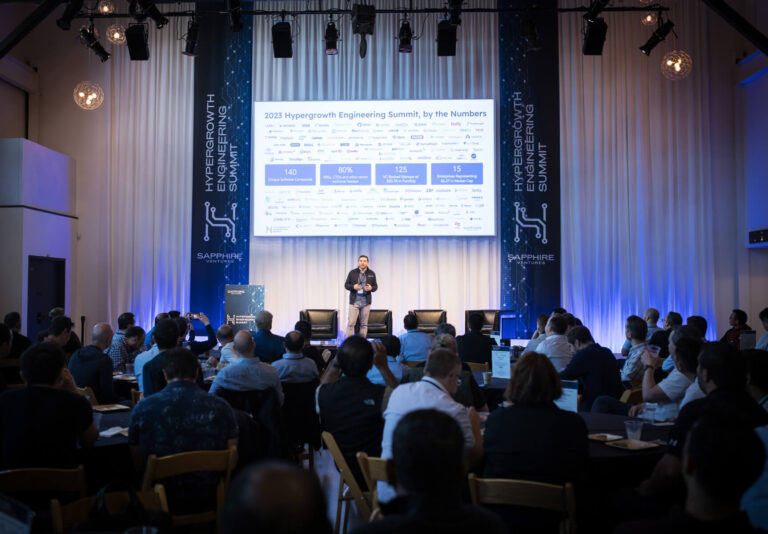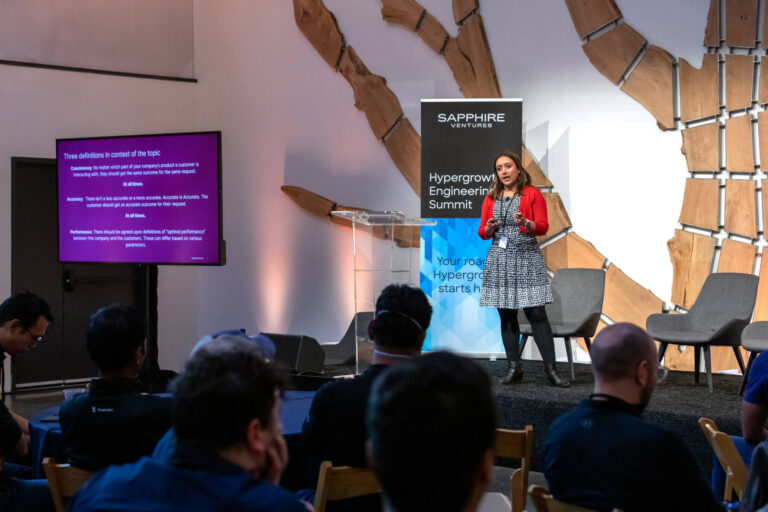When Sapphire introduced the CIO Innovation Index in 2019, it was the first of its kind research for CIOs and enterprise technology leaders to benchmark emerging technology adoption, startup engagement and their personal connection to startups. Since then, the report has served as a guidepost for how, when and in what industries enterprises are innovating and adopting startup technologies. For example, last year, our CIO Innovation Index uncovered that enterprise spend with startups would grow from 10% of their overall vendor budget to 15%. And just as expected, that prediction came true.
Each year, in addition to our year-over-year research on areas including technology spend across categories, share of budget going to startups and the proof-of-concept process, we aim to address overarching, top-of-mind themes affecting our corporate network. In years past, we explored topics such as the future of the CIO role, the impact of the pandemic on enterprise innovation and what the next normal of work will look like. This year, we’ve found that the inflection point for our network concerns corporate purpose.

As a venture capital firm investing in high-growth startups, our goal is to partner with companies that share our values and emphasize the employee experience. We’re proud to have backed founders like Auth0 CEO Eugenio Pace who imbue their leadership with clear values. Many argue that part of the startup ethos that attracts and inspires employees and investors alike has to do with establishing a shared purpose. Harvard Business School professor Ranjay Gulati once wrote that the soul of a startup is characterized by, “Three elements that combine to create a unique and inspiring context for work: business intent, customer connection and employee experience.”
It’s become clear that soul-searching is not exclusive to startups. Massive changes in the world around us have resulted in re-prioritization for the global workforce. And these changes in priorities have triggered what is being called the “Great Resignation” with millions of employees leaving their jobs and millions more considering it. We took these changes into account when designing our 2021 CIO Innovation Index. This year’s report dives into how shifting employee priorities, the Great Resignation and a new focus on corporate purpose are impacting Sapphire’s executive network–and what this means for CIOs going forward.
A Lasting Impact on Workforce Strategy
A commitment to positive employee experience is no doubt a statement of corporate purpose. In response to employee demands and strategic shifts, 91% of survey respondents are making changes to their workforce strategy with an overwhelming majority (88%) introducing more flexibility in remote versus in-office work as a key component of their new strategy. Startups are mission-critical to enabling these strategic shifts.
In fact, 86% of respondents are utilizing startups to support shifts to remote work.
At our recent Sapphire Vision Summit, Sapphire Partner Cathy Gao spoke with executives from Meta, Gilead and Sapphire portfolio company Degreed on the changes they’re witnessing and executing for their workforce strategy– and dived deeper into the source of these changes.
“We’re seeing a reckoning of employees who were living to work [who are] thinking about: ‘is that actually what is actually true to my value and my purpose?’ Individuals are now thinking what does it mean to work to live,” said Degreed’s President and Chief Experience Officer Kat Kennedy, “and that has really put the onus on organizations to focus on a people-first strategy.”
At Sapphire, we firmly believe that the renewed focus on employee experience isn’t going anywhere anytime soon. In the past year alone, we’ve invested in a number of startups in this year alone including Gem, Degreed, BetterUp and Unmind that are focused on employee engagement, development, wellbeing and overall experience, and we continue to make bets on the future of work space. While these technologies are certainly helping companies of all sizes adapt to new ways of working and the employee experience overall, we’re finding that employees are looking for more than increased flexibility and better benefits. They are looking for corporate purpose.
“Employees are increasingly seeking fulfillment,” observed Marc Berson, CIO at Gilead Sciences, “And focusing that fulfillment on their company’s purpose and mission. So at Gilead Sciences, it’s easy for us to inspire people around our mission–we have cancer therapies and HIV therapies and COVID therapies. Human lives are literally impacted by our products. We’re doubling down on communicating that mission and making sure people understand their individual contributions to that broader mission.”
This mission is different for every organization, but clearly stating it and acting on it is a huge component of keeping employees engaged and improving their work experience.
Technology’s Role in Driving ESG: A Strategic Imperative
ESG (or Environment, Social, and Corporate Governance) is not a new term, and certainly not for the Global 2000 enterprises in our network, but it is increasingly a strategic (and regulatory) imperative. Employee re-prioritization, which is driving changes in workforce strategy, paired with consumer demands is putting pressure on corporations to define their shared values and commitment to areas like sustainability, social good and strong corporate governance.
Our network of technology executives are incorporating ESG strategy into their technology strategy as responsibility for tooling, data and reporting around ESG principles often falls to technology teams. It’s inspiring to see that 87% of Innovation Index respondents are planning to adopt technology tools across areas like sustainability, DEI and data privacy.
As University of San Francisco’s VP and Chief Information Officer Opinder Bawa notes, “ESG principles like sustainability and a commitment to diversity, equity and inclusion are a key facet of our strategy–and we are actively adopting technology solutions to help support these goals.”
Sustainability in particular is a growing focus for Sapphire’s investment team and an exciting space for innovative startups. Our Sapphire Partners team has long been invested in VCs with sustainability theses, and we continue to see startups tackling the sustainability challenges our network is facing. If enterprises are truly going to get serious about sustainability, they’ll need to start working with this landscape of new players.
The Purposeful CIO
This brings us to the question of how the CIO role continues to evolve in light of current ways of working, new expectations for employees and a focus on corporate purpose. For many in our network, the pandemic highlighted the leadership element of their jobs: managing a global team, taking care of their employees and communicating more transparently than ever before.
As Amy Hayes, VP of Learning and Development at Meta put it, the difficult times of the past two years have called “on leaders to be more human, and focus on humanity and be more empathetic.”
As company values are established at the very highest levels, CIO responsibilities include supporting those values with technology and continuing to lead by example. Hybrid work is becoming a de facto operating model for many corporations and the technology that allows distributed employees to connect, collaborate and communicate is mission critical. Furthermore, as companies make major public commitments to sustainability, DEI and customer privacy, they are also accountable to deliver on these commitments with data.
Startups’ Role in Powering Today’s Enterprise
Luckily, startups can help support all of these priorities–from building an inclusive company culture, to tracking Scope 3 emissions, to ensuring watertight data governance. In many cases, startups are actually much better positioned to support these new areas compared to large incumbents that are themselves still figuring out how corporate purpose fits into their strategy. Many of the emerging technology categories that we introduced at the inception of our survey have become table-stakes, and we’re experiencing a relentless pace of innovation across the entire landscape.
As touched on earlier, it’s exciting to see that enterprise CIOs are growing their spend with startups–from 10% of overall vendor budgets in the past two years to 15% this year. And there are more ways than ever to discover and engage with innovative startups.
We’re proud to note that 72% of our survey respondents find VCs like Sapphire to be among the most important sources of information on the innovation ecosystem.
We’re also seeing usage of new channels like cloud marketplaces become more popular with 79% of respondents using cloud marketplaces to discover and procure startups.
Keeping in sync with the startup ecosystem has always been crucial to understanding advances in traditional CIO areas such as data tooling, enterprise architecture and cybersecurity. We also urge CIOs to stay in tune with the startup ecosystem in not-so-traditional areas like the ones we’ve highlighted in this year: ESG tooling, digital accessibility solutions and employee experience platforms. If the past three years of running this Index taught us anything, it’s that these emerging areas will soon be commonplace as well.
Download the 2021 Innovation Index

To get a deeper look at our year-over-year tracking of emerging technology adoption, startup engagement processes, as well as 2021 data on workforce strategies and ESG tooling, download this year’s CIO Innovation Index Report today!



